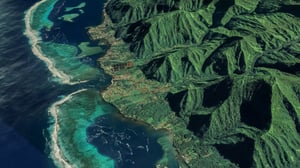In today's world, natural disasters are becoming more frequent and severe, and they are causing significant damage to communities around the globe. To effectively protect these communities from the impacts of natural disasters, it is essential that we can identify the communities that are most at risk. One of the most powerful tools for identifying vulnerable communities is satellite data.
Satellite data can provide detailed information about a wide range of factors that can contribute to a community's vulnerability to natural disasters. For example, satellite data can be used to map the location of buildings, roads, and other infrastructure, which can help to identify communities that are at risk of flooding or landslides. Satellite data can also be used to map the location of vegetation, which can help to identify communities that are at risk of wildfires.
In addition to mapping the physical characteristics of a community, satellite data can also be used to identify the demographic characteristics of a community. For example, satellite data can be used to map the location of schools, hospitals, and other critical infrastructure, which can help to identify communities that are at risk of losing access to essential services during a natural disaster.
One example of a case study where satellite data and machine learning were used to increase the resolution of census, socio-economic, and demographic metrics to better model social vulnerabilities is the project "Mapping Community Vulnerability to Natural Hazards in the Philippines using Satellite Imagery and Machine Learning" by R. B. Briones et al., published in the journal Remote Sensing of Environment (2019).
The study aimed to map community vulnerability to natural hazards in the Philippines using satellite data and machine learning. The authors used satellite imagery to map the physical characteristics of communities, such as land cover, land use, and infrastructure. They also used census data to map the demographic characteristics of communities, such as population density and socio-economic status.
The authors then used machine learning algorithms to combine the satellite data and census data to create a map of community vulnerability to natural hazards. The results of the study showed that the method can be used to identify vulnerable communities in disaster-prone areas with high accuracy.
The study found that by integrating satellite data with census data and machine learning, they were able to increase the resolution of demographic data and better model social vulnerabilities. The results of the study showed that the method can be used to identify vulnerable communities in disaster-prone areas with high accuracy. Additionally, this approach can be used to develop targeted disaster risk reduction strategies to protect these vulnerable communities from the impacts of natural hazards.
Some other recent works, scientific papers, and projects relevant to using satellite data to identify vulnerable communities and develop targeted disaster risk reduction strategies include:
- "Satellite-based mapping of social vulnerability to natural hazards in the United States" by J. L. Cinner et al., published in the journal Nature Sustainability (2019). This study used satellite data to map social vulnerability to natural hazards in the United States and found that satellite-based indicators can be used to identify vulnerable communities at a fine scale.
- "Exploiting satellite data for community vulnerability assessment in disaster risk management" by S. G. Ghosh et al., published in the journal International Journal of Disaster Risk Reduction (2018). This study used satellite data to assess community vulnerability to natural hazards in India and found that the method can be used to identify vulnerable communities and develop targeted disaster risk reduction strategies.
- "Using satellite data to identify vulnerable communities in the Caribbean" by S. G. Ghosh et al., published in the journal Natural Hazards (2017). This study used satellite data to identify vulnerable communities in the Caribbean and found that the method can be used to identify communities at risk of natural hazards and develop targeted disaster risk reduction strategies.
- The project "Satellite-Based Identification of Vulnerable Communities in Africa" by the United Nations Office for Disaster Risk Reduction (UNDRR) is a project that aims to use satellite data to identify vulnerable communities in Africa and develop targeted disaster risk reduction strategies.
.png?width=1080&height=1080&name=Satellite-Vulnerable-Communities-1%20(1).png)
Kansas City, USA
Once a community has been identified as vulnerable, the data collected can be used to develop targeted disaster risk reduction strategies. For example, if a community is identified as being at risk of flooding, targeted flood protection measures such as building levees or raising buildings can be implemented to reduce the risk of flooding. If a community is identified as being at risk of wildfire, targeted wildfire protection measures such as creating fire breaks or thinning vegetation can be implemented to reduce the risk of wildfire.
Social vulnerability refers to the lack of resources, capacities, and resilience of communities to cope with and recover from disasters. Here are a few ways to mitigate social vulnerability:
- Building Resilience: Building resilience means making communities more robust to disasters by strengthening their ability to withstand and recover from them. This can be done by investing in infrastructure such as improving housing, roads, and hospitals. Additionally, educating communities on how to prepare and respond to disasters can also increase their resilience.
- Providing Support: Providing support to vulnerable communities can help to mitigate social vulnerability by addressing the underlying causes of vulnerability such as poverty, lack of education, and lack of access to healthcare. This can be done by providing financial assistance, education and training opportunities, and access to healthcare services.
- Community Engagement: Community engagement means involving communities in the planning and implementation of disaster risk reduction strategies. This can be done by involving community members in the planning process, providing them with information about the risks they face, and encouraging them to take ownership of their own safety and resilience.
- Urban Planning: Urban planning is the process of designing, developing, and managing the physical layout of communities. Urban planners can design communities in ways that reduce vulnerability to disasters, by ensuring that buildings, roads, and other infrastructure are built to withstand natural hazards, and by creating safe and accessible evacuation routes.
- Green Infrastructure: Green infrastructure refers to the use of natural elements such as trees, wetlands, and green roofs to manage water and mitigate the effects of extreme weather. Green infrastructure helps to reduce the risk of flooding and landslides, cool down the air and make urban areas more liveable.
Geoneon uses a similar approach of using satellite data, deep learning, data fusion, and data modelling to map and better understand social vulnerability. By using satellite data, Geoneon can map the physical characteristics of communities, such as land cover, land use, and infrastructure. This data is then combined with other data sources such as census data and socio-economic data to create a more complete picture of a community's vulnerability to natural hazards.
Deep learning algorithms are used to analyse this data and identify patterns that can be used to predict a community's vulnerability to natural hazards. This allows Geoneon to create highly accurate maps of social vulnerability that can be used to target disaster risk reduction efforts and protect vulnerable communities.
Data fusion is used to combine multiple data sources and create a more complete picture of a community's vulnerability. This can include combining satellite data with data from other sources such as social media, weather data, and government data.
Finally, data modelling is used to create simulations of potential disasters and their impacts on communities. These simulations can be used to test different disaster risk reduction strategies and identify the most effective ways to protect vulnerable communities.
Overall, Geoneon's approach of using satellite data, deep learning, data fusion, and data modelling allows for a more complete and accurate understanding of social vulnerability, which in turn enables to develop targeted disaster risk reduction strategies to protect vulnerable communities.
In conclusion, satellite data is a powerful tool for identifying vulnerable communities and developing targeted disaster risk reduction strategies. By using satellite data, we can better understand the risks facing communities around the world and take steps to protect these communities from the impacts of natural disasters.

